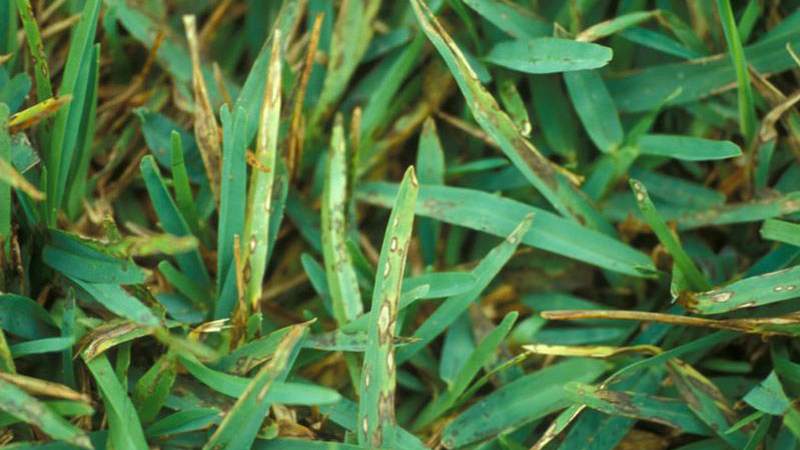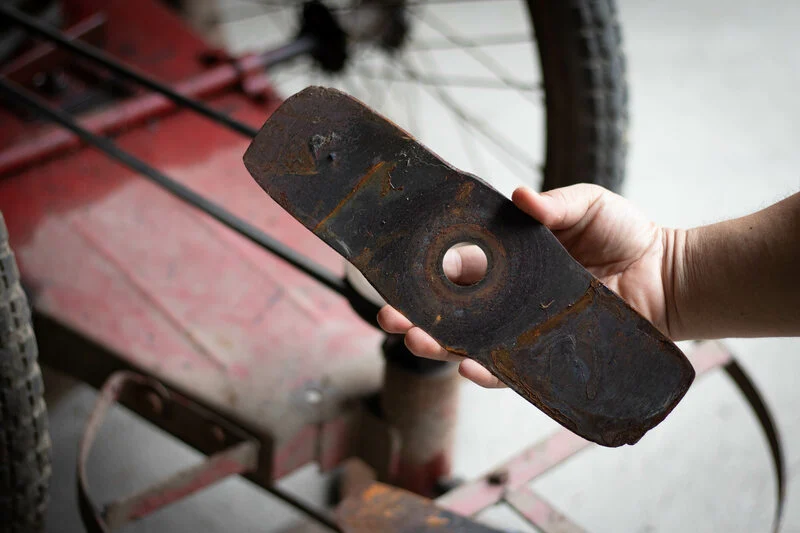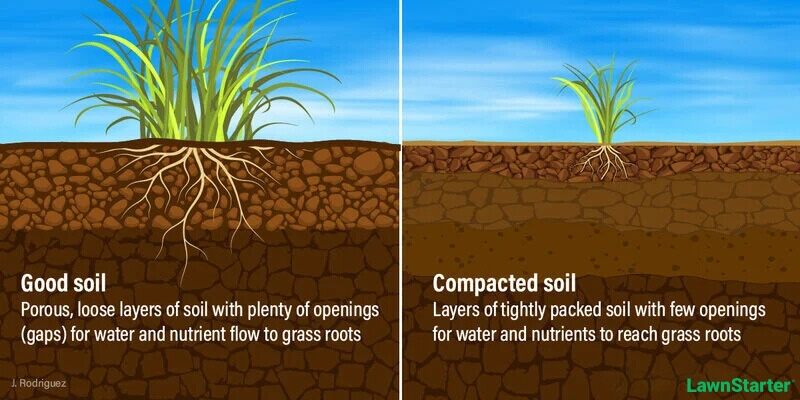
When your lawn is soaked from rain or dew, you may wonder if it’s okay to mow. For best results, you should wait until your lawn dries first.
There are many reasons why you shouldn’t mow wet grass: It can tear your grass, trim grass unevenly, compact your soil, or spread lawn diseases around the yard. Mowing wet grass will also clog your lawn mower, and slippery grass can become a safety hazard.
1. Uneven Cuts Damage Your Lawn
Mowing wet grass is like giving your lawn a bad haircut. Instead of a nice trim, you end up with torn grass blades and brown tips.
Mowing wet grass results in an uneven cut due to the weight of the water, causing the grass blades to bend over. When the blades aren’t standing up straight, your mower can’t cut them evenly, leading to a patchy and choppy appearance. Once the grass dries and stands up straight, the unevenness becomes even more noticeable.
This means you’ll have to mow again to achieve a neat and uniform look. To avoid this double effort and keep your lawn looking its best, wait for the grass to dry. Or, if you don’t want to deal with the hassle of achieving the perfect cut yourself, hire a lawn care pro to mow your lawn for you.
Read More: Lawn Mowing Tips: How to Mow a Lawn the Right Way
2. Increased Risk of Lawn Disease

Photo Credit: NC State Cooperative Extension
Mowing wet grass can create the perfect environment for lawn diseases to thrive. When you mow wet grass, the blades are more likely to tear and form clumps in the lawn, making your lawn susceptible to infections from fungal diseases.
Additionally, wet grass is sticky and will cling to your lawn mower (if you fail to clean the deck after you mow). Fungi and mold can grow where there are clumps of wet grass, so the next time you mow, mold or fungi growing on your mower blades will spread fungal diseases over your lawn.
To avoid spreading lawn fungi like brown patch, anthracnose, leaf spot, and red thread, wait until your grass is dry before mowing.
3. Mower Damage

Mowing wet grass can damage your lawn mower. Water from the grass can seep into the fuel tank, causing the engine to malfunction or even stop working.
Wet grass clippings clump up, blocking the vacuum or blade, which forces your mower to work harder. When the blade struggles to spin, it puts extra pressure on the engine, which can result in smoking and overworking. Electric mowers are especially vulnerable since they have less torque than gas-powered mowers, making it harder for them to power through thick, wet grass.
The moisture from wet grass blades stuck to your lawn mower can also cause the blades and other metal components to rust or corrode, leading to expensive repairs or the need to replace your mower altogether.
My Experience: One mowing day I decided to get an early start, while a layer of morning dew was still sparkling on the grass. That ended up being a bad idea. It didn’t take long before the damp grass clogged up my lawn mower blades, putting additional strain on the engine and slowing down the whole mowing process.
After removing dense clumps of wet grass from my mower blades, I still had to wait for the lawn to dry so that I could mow. That day, I learned that while it’s tempting to get an early start trimming the grass, waiting just an hour or two later means much less time, effort, and strain spent on this straightforward lawn care chore.
Read More:
4. Safety Hazards
Cutting wet grass isn’t just bad for your lawn and mower; it’s also risky for you. Slick grass can turn your yard into a slip-and-slide, especially on hilly or sloping terrain. This could lead to injuries, turning a simple yard chore into a safety hazard. In fact, over 250,000 people were treated for injuries related to lawn mowers in 2010, according to the U.S. Consumer Product Safety Commission.
If you use an electric lawn mower, especially one with an extension cord, there’s a risk of electric shock when operating in wet conditions. Water and electricity are a dangerous mix, and mowing wet grass increases the likelihood of a mishap.
5. Soil Compaction and Rutting

The trouble doesn’t stop there; running your mower over wet soil results in compacted soil, suffocating the roots by cutting off their oxygen supply. This leads to thin, patchy grass or can cause ruts in your lawn.
Wet grass clippings also clump together, blocking sunlight, water, and airflow, and turning your lawn into a patchy, suffocated mess. If this happens, you may need to aerate your lawn to relieve the compaction and allow air and water to flow freely.
6. Poor Mulching and Bagging Performance
Grass clippings are a natural fertilizer for your yard. Instead of bagging the grass, some homeowners opt to use grass clippings as mulch by leaving behind a thin layer of freshly mowed grass on their lawn.
However, grasscycling will not work when the grass is wet. Instead of grass naturally spreading over the yard, it will form clumps of grass on your lawn. Wet grass sticks to everything, so most of the wet grass will stick to the sides of your lawn mower instead of filtering into the bag.
7. Inefficient Fuel Use
When you mow wet grass, your lawn mower will consume more fuel with less output. The weight of soaking grass in your lawn mower bag slows down your progress and makes it harder to push. This forces your lawn mower to work harder to compensate for the extra weight, reducing its fuel efficiency.
8. Clothing Stains
Mowing wet grass is a recipe for a mess. Wet grass is more likely to stick to you and leave behind stains on your clothes. Wet grass clippings stick to everything: your shoes, the mower wheels, and just about any surface they touch. This means you’ll end up with grass stains everywhere.
FAQ About Mowing Wet Grass
The best mowing technique is to wait 2 to 5 hours after a light rain or a full day after heavy rainfall. Take a walk through your lawn to test the moisture levels in your yard. If your shoes get damp, wait a bit longer before cutting the grass.
Read More: When Not to Mow Your Lawn
Sometimes a long rainy spell strikes, and you can’t put off your mowing chores any longer. While mowing dry grass is ideal, it’s better to cut slightly wet grass than let it grow excessively high, recommends Purdue University.
If you must mow wet grass, here are some tips to make the process a little easier:
● Sharpen mower blades: Sharp blades make clean(er) cuts on wet grass, reducing the risk of damage.
● Raise mower height: Wet grass is difficult to cut cleanly at lower settings. “Set your mower as high as possible,” recommends the Kansas State University Research and Extension.
● Mow slowly: Take your time mowing wet grass. Moving slowly will help the mower blades cut more effectively and prevent an uneven finish.
● Use side discharge: Instead of mulching or bagging, use the side discharge option. Wet grass clippings can clog a mulching mower and cake up inside a bag.
● Clean mower frequently: Periodically stop to clean the lawn mower deck. This prevents grass from clogging the blades.
Cutting grass with morning dew is not advisable. Mowing damp grass can damage your lawn, harm your mower, and even pose a safety risk to yourself. The best time to mow is always when the grass is dry.
Save Mowing for a Dry Day
Can you mow wet grass? Sure, if you want to deal with major mowing issues like compacted soil, lawn diseases, unevenly trimmed grass, or damage to your mower. To avoid these problems, make it a rule that you only mow your grass when it’s dry.
Whether your home is experiencing a long dry spell or drowning in the rainy season, the best way to achieve a perfect lawn is to hire a lawn care professional in your area to trim your grass for you.
Sources:
- “K-State Expert Offers Tips When Lawn is Too Wet to Mow.” By Pat Melgares, news and feature writer. Kansas State University.
- “Lawn Diseases.” University of Florida/IFAS Extension.
- “Lawn Mower Safety.” By Sammy Sadaka, assistant professor and extension engineer. University of Arkansas Extension.
- “Mowing Wet Grass.” By Zac Reicher. Purdue University.
Main Photo Credit: Serhii / Adobe Stock Free / License